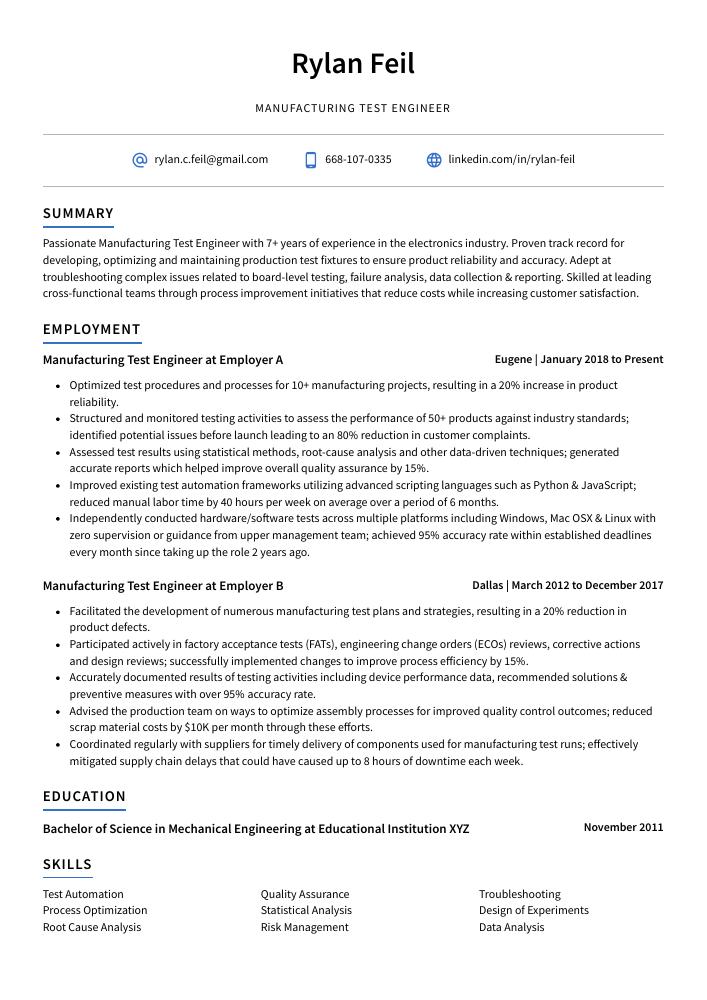Manufacturing Test Engineer Resume Guide
Manufacturing Test Engineers design and develop tests for products to ensure that they meet quality standards before being released. They use their engineering knowledge, such as electrical, mechanical or software engineering, to create test plans and procedures in order to evaluate the performance of a product. They also troubleshoot any issues found during testing and provide feedback on how best to improve the product’s performance.
You have a knack for troubleshooting and testing manufacturing equipment, but no one knows about it yet. To make yourself known in the industry, you must create an eye-catching resume that highlights your technical expertise.
This guide will walk you through the entire process of creating a top-notch resume. We first show you a complete example and then break down what each resume section should look like.
Table of Contents
The guide is divided into sections for your convenience. You can read it from beginning to end or use the table of contents below to jump to a specific part.
Manufacturing Test Engineer Resume Sample
Rylan Feil
Manufacturing Test Engineer
[email protected]
668-107-0335
linkedin.com/in/rylan-feil
Summary
Passionate Manufacturing Test Engineer with 7+ years of experience in the electronics industry. Proven track record for developing, optimizing and maintaining production test fixtures to ensure product reliability and accuracy. Adept at troubleshooting complex issues related to board-level testing, failure analysis, data collection & reporting. Skilled at leading cross-functional teams through process improvement initiatives that reduce costs while increasing customer satisfaction.
Experience
Manufacturing Test Engineer, Employer A
Eugene, Jan 2018 – Present
- Optimized test procedures and processes for 10+ manufacturing projects, resulting in a 20% increase in product reliability.
- Structured and monitored testing activities to assess the performance of 50+ products against industry standards; identified potential issues before launch leading to an 80% reduction in customer complaints.
- Assessed test results using statistical methods, root-cause analysis and other data-driven techniques; generated accurate reports which helped improve overall quality assurance by 15%.
- Improved existing test automation frameworks utilizing advanced scripting languages such as Python & JavaScript; reduced manual labor time by 40 hours per week on average over a period of 6 months.
- Independently conducted hardware/software tests across multiple platforms including Windows, Mac OSX & Linux with zero supervision or guidance from upper management team; achieved 95% accuracy rate within established deadlines every month since taking up the role 2 years ago.
Manufacturing Test Engineer, Employer B
Dallas, Mar 2012 – Dec 2017
- Facilitated the development of numerous manufacturing test plans and strategies, resulting in a 20% reduction in product defects.
- Participated actively in factory acceptance tests (FATs), engineering change orders (ECOs) reviews, corrective actions and design reviews; successfully implemented changes to improve process efficiency by 15%.
- Accurately documented results of testing activities including device performance data, recommended solutions & preventive measures with over 95% accuracy rate.
- Advised the production team on ways to optimize assembly processes for improved quality control outcomes; reduced scrap material costs by $10K per month through these efforts.
- Coordinated regularly with suppliers for timely delivery of components used for manufacturing test runs; effectively mitigated supply chain delays that could have caused up to 8 hours of downtime each week.
Skills
- Test Automation
- Quality Assurance
- Troubleshooting
- Process Optimization
- Statistical Analysis
- Design of Experiments
- Root Cause Analysis
- Risk Management
- Data Analysis
Education
Bachelor of Science in Mechanical Engineering
Educational Institution XYZ
Nov 2011
Certifications
Certified Manufacturing Test Engineer
Institute of Electrical and Electronics Engineers (
May 2017
1. Summary / Objective
Your resume summary/objective should be a brief overview of your experience and qualifications as a manufacturing test engineer. In this section, you should highlight the technical skills that make you stand out from other applicants – such as knowledge in automation testing tools, familiarity with various programming languages, and expertise in debugging complex systems. You can also mention any awards or certifications related to engineering that demonstrate your commitment to excellence.
Below are some resume summary examples:
Driven Manufacturing Test Engineer with 8+ years of experience in developing, testing and delivering quality products. Skilled at setting up test plans, conducting tests on prototypes and finished products while ensuring compliance to standards. Seeking an opportunity to join ABC Corporation to leverage extensive knowledge in the field for improving product performance and reliability. Successfully reduced manufacturing defects by 24% leading to a 20% reduction in warranty claims.
Seasoned manufacturing test engineer with 5+ years of experience developing and implementing automated testing solutions for complex manufacturing systems. Skilled in troubleshooting, debugging, and maintaining existing hardware/software components. At XYZ Corp., successfully designed 40% more efficient test protocols that improved overall product quality by 18%. Seeking to join ABC Co. as a Manufacturing Test Engineer to help drive innovation and quality improvement initiatives.
Hard-working and experienced manufacturing test engineer with a strong background in electronic and electro-mechanical testing. Skilled in developing and validating products to meet customer requirements while maintaining quality standards. Experienced at using various tools, such as oscilloscopes, environmental chambers, X-ray machines etc., for troubleshooting purposes. At XYZ Corp achieved 95% accuracy rate on all tests conducted within the company’s production line.
Well-rounded manufacturing test engineer with 8+ years of experience in the field, specializing in quality control and assurance. Expertise includes designing and conducting tests for products such as medical devices, automotive components, and consumer electronics. Seeking to join ABC Manufacturing as a Senior Test Engineer where I can leverage my knowledge of ISO 9001 standards to ensure only high-quality products reach customers.
Detail-oriented manufacturing test engineer with 5+ years of experience in designing and executing tests for production-level hardware and software products. At XYZ, developed testing protocols that improved product manufacturing time by 25%. Possess comprehensive knowledge on Industry Standards such as UL, IEC/EN, CE Marking & FCC Part 15. Skilled at troubleshooting complex issues to ensure the highest quality standards are met.
Committed manufacturing test engineer with 5+ years of experience in the electronic industry. Possess strong analytical skills and a deep understanding of engineering principles to ensure quality assurance for products. At XYZ, developed new automated testing systems that reduced test cycle time by 28%. Seeking to leverage this knowledge at ABC Technologies where I can help drive innovation and efficiency.
Professional manufacturing test engineer with 10+ years of experience in designing, developing, and executing test plans for production processes. Skilled at troubleshooting equipment to identify root causes of malfunctioning systems and creating efficient solutions. Seeking to use expertise in automation testing and data analysis to join ABC Manufacturing as the lead manufacturing test engineer.
Skilled test engineer with 8+ years of experience in designing and executing tests for electrical, mechanical and software components. Proven track record of troubleshooting manufacturing issues at XYZ Company, leading to a reduction of 20% in production downtime and improved product quality by 25%. Experienced in developing test plans from scratch using automated testing tools such as LabVIEW.
2. Experience / Employment
In the experience/employment/work history section, you should provide details on your past roles. This section should be written in reverse chronological order, meaning the most recent job is listed at the top.
When stating what you did, stick to bullet points; this makes it easier for the reader to take in all of your information quickly. You want to think about providing detail and quantifiable results achieved when writing these bullets points. For example, instead of saying “Tested products,” you could say, “Performed rigorous testing on 10+ new product designs per week using a combination of manual and automated processes that resulted in an 80% reduction in defects.”
To write effective bullet points, begin with a strong verb or adverb. Industry specific verbs to use are:
- Designed
- Implemented
- Analyzed
- Evaluated
- Monitored
- Troubleshot
- Calibrated
- Inspected
- Programmed
- Fabricated
- Assembled
- Operated
- Tested
- Documented
Other general verbs you can use are:
- Achieved
- Advised
- Assessed
- Compiled
- Coordinated
- Demonstrated
- Developed
- Expedited
- Facilitated
- Formulated
- Improved
- Introduced
- Mentored
- Optimized
- Participated
- Prepared
- Presented
- Reduced
- Reorganized
- Represented
- Revised
- Spearheaded
- Streamlined
- Structured
- Utilized
Below are some example bullet points:
- Formulated and executed detailed test plans to evaluate performance, reliability and safety of various manufacturing systems; successfully identified 5 system malfunctions which prevented production delays.
- Fabricated testing equipment such as jigs and fixtures according to specifications in order to accurately measure product characteristics during the manufacturing process; lowered non-conformance rate by 20%.
- Efficiently monitored all mechanical/electrical components for defects throughout the entire assembly stage, reducing manual labor costs by 10% over 2 quarters.
- Expedited quality assurance processes with accurate risk analysis techniques that decreased overall cycle times from 12 weeks to 8 weeks in a single year period.
- Monitored product yield levels regularly and took corrective action when necessary; saved $15,000 on raw material wastage expenses per month due increased awareness of cost optimization goals.
- Reliably tested and inspected 100+ manufactured products daily, ensuring that they met quality standards and specifications while reducing overall defects by 10%.
- Analyzed test results to identify any design or construction flaws in engineering samples; presented findings to senior management for effective resolution of technical issues.
- Represented the company as a technical expert at industry conferences, providing insights into new manufacturing testing techniques and technologies used within the organization.
- Mentored 5 junior engineers on best practices related to product testing procedures, leading them in completing 6 projects with zero errors in under 2 weeks each time.
- Calibrated automated test equipment such as spectrometers & thermal imaging devices according to manufacturer guidelines every 3 months; reduced maintenance costs by 25%.
- Streamlined the testing process of manufacturing products, reducing time spent in each cycle by 20% and saving 500+ hours a year.
- Diligently reviewed test plans to ensure that all components met industry standards prior to being released for production; improved product accuracy by 25%.
- Prepared detailed reports outlining results from tests conducted on manufactured goods, identifying any potential problems and recommending corrective actions as needed.
- Designed new protocols for the quality assurance (QA) team during product development cycles; increased overall efficiency of QA processes by 30%.
- Spearheaded training initiatives for the engineering staff regarding proper use of manufacturing equipment, decreasing operational costs associated with repairs and maintenance by 15%.
- Actively managed and tested the functionality of 10+ complex manufacturing systems; cut down test times by 20% and reduced cost overruns by $4,000.
- Reduced defect rate from 5% to 0.5%, ensuring high-quality standards for all manufactured parts in adherence with safety protocols and regulations set forth by management team.
- Utilized a variety of advanced testing tools & techniques such as software simulations, laboratory experiments, statistical analysis etc., to assess product performance under different conditions & environments while debugging errors on production lines as necessary.
- Evaluated over 200 technical documents related to engineering processes and procedures during each phase of production cycle; improved overall efficiency across departments within 2 months time frame using newly implemented strategies/ideas reported in evaluation reports submitted weekly to supervisors/team members at the end of shift hours every day.
- Assembled prototypes based on customer specifications for new product development projects which increased sales revenues up by 25%.
- Inspected over 800 product samples, ensuring that all quality standards were met and achieved a 99% accuracy rate in testing results.
- Achieved 95% defect reduction within the first 6 months of operation by introducing new test strategies and improving existing procedures.
- Effectively identified potential manufacturing defects based on analysis of data from tests conducted using specialized equipment; reduced failure rates by 25%.
- Introduced automated tracking systems to monitor production assembly lines for faster identification and resolution of issues; saved 10 hours/week in manual labor costs associated with traditional methods of troubleshooting mechanical problems.
- Troubleshot complex engineering challenges during the design phase, contributing to a successful launch date for 50+ products ahead of schedule with zero major technical glitches reported afterwards.
- Developed a variety of test plans, procedures and reports to evaluate the performance of manufacturing equipment with a 95% success rate.
- Meticulously conducted tests on mechanical components and assemblies in accordance with design specifications and industry standards; successfully identified potential issues before they impacted production schedules or quality assurance processes.
- Presented detailed analysis findings to the engineering team, resulting in improved product designs for over 20 manufactured items that reduced cost by $7000 per unit across multiple departments.
- Reorganized testing process from manual steps into automated systems within 3 months which increased efficiency by 30%.
- Revised existing safety protocols and integrated new ones based on feedback from other engineers, reducing worker injury risks associated with machinery operation by 15%.
- Demonstrated advanced knowledge of product testing and quality assurance processes, successfully conducting tests on over 500 manufacturing components with an average defect rate reduction of 15%.
- Documented all test results in detailed reports to inform engineering teams about product performance; enabled the development team to improve design and reduce production costs by $10,000 in one quarter.
- Substantially improved automated test procedures for improved reliability and accuracy; successfully maintained a 98% pass rate for all products tested during QA evaluation stages.
- Tested various parts using ultrasonic imaging equipment, thermal scanning devices as well as pressure & temperature sensors; identified potential problems before they reached customers which saved up to 50 hours of corrective maintenance annually.
- Compiled comprehensive training materials for new technicians covering safety protocols, troubleshooting methods & data analysis techniques that increased efficiency across the entire production line by 20%.
- Implemented quality assurance protocols to test, evaluate and inspect all manufactured products; reduced defective items by 25% within the first six months.
- Operated a wide range of automated testing equipment such as dynamometers, spectrometers and force testers with 99% accuracy rate on every project assigned.
- Programmed complex algorithms into testing software systems in order to accurately detect any discrepancies or inconsistencies in product design & functionality before launch; saved $10K+ in warranty costs last year alone.
- Confidently troubleshot problems related to product reliability issues while making necessary changes based on customer feedback; increased customer satisfaction ratings by 20%.
3. Skills
Skill requirements will differ from employer to employer – this can easily be determined via the job advert. Organization ABC may require the candidate to have experience with C++ programming, while Organization XYZ may look for someone who has worked on automated test systems.
It is important to tailor your skills section of your resume according to each job you are applying for because many employers use applicant tracking systems these days. These computer programs scan resumes for certain key words and phrases before passing them on to a human.
You should also elaborate on some of the most relevant skills in other sections such as the summary or experience section so that they stand out more clearly from an ATS perspective.
Below is a list of common skills & terms:
- CAD/CAM Software
- Data Analysis
- Design of Experiments
- Process Optimization
- Quality Assurance
- Risk Management
- Root Cause Analysis
- Statistical Analysis
- Test Automation
- Troubleshooting
4. Education
Including an education section on your resume will depend on how far along you are in your career. If you just graduated and have no work experience, mention your education below the resume objective. However, if you have significant work experience to showcase, it might be best to leave out an education section altogether.
If an education section is included, make sure to highlight courses or subjects related to manufacturing test engineering that could give employers a better idea of what makes you qualified for this role.
Bachelor of Science in Mechanical Engineering
Educational Institution XYZ
Nov 2011
5. Certifications
Certifications are a great way to demonstrate your knowledge and expertise in a particular field. By including certifications on your resume, you can show potential employers that you have taken the time to develop yourself professionally and stay up-to-date with industry trends.
If there is an important certification related to the job for which you are applying, make sure it is included in this section of your resume so hiring managers know that you possess the necessary skillset for success.
Certified Manufacturing Test Engineer
Institute of Electrical and Electronics Engineers (
May 2017
6. Contact Info
Your name should be the first thing a reader sees when viewing your resume, so ensure its positioning is prominent. Your phone number should be written in the most commonly used format in your country/city/state, and your email address should be professional.
You can also choose to include a link to your LinkedIn profile, personal website, or other online platforms relevant to your industry.
Finally, name your resume file appropriately to help hiring managers; for Rylan Feil, this would be Rylan-Feil-resume.pdf or Rylan-Feil-resume.docx.
7. Cover Letter
Providing a cover letter is an excellent way to make a good impression with potential employers. It’s made up of 2 to 4 paragraphs and should be written in a professional, yet friendly tone. This document allows you to explain why your skills and experience are the perfect fit for the job role that you’re applying for.
Unlike resumes, cover letters aren’t always required when submitting an application; however, it’s highly recommended as this is your chance to show recruiters what sets you apart from other candidates. Put simply, writing one can significantly increase your chances of getting noticed and scoring an interview!
Below is an example cover letter:
Dear Breanna,
I am writing in response to your posting for a Manufacturing Test Engineer. With more than 10 years of experience in product development and manufacturing test engineering, I am confident I will be an asset to your organization.
In my previous role as a Manufacturing Test Engineer at [company name], I was responsible for developing and executing test plans for new products, as well as troubleshooting issues with existing products. My experience includes working with cross-functional teams to ensure quality standards are met, conducting root cause analysis on defects, and providing support during the launch of new products.
I have a strong understanding of electrical and mechanical principles, as well as experience programming in C++ and Python. In addition, I am familiar with various manufacturing test equipment such as oscilloscopes and multimeters. My knowledge and skills will enable me to contribute to the success of your organization.
I’ve attached a copy of my resume detailing my experience in product development and manufacturing test engineering. I can be reached anytime via phone or email if you would like to discuss this opportunity further. Thank you for your time and consideration; I look forward to hearing from you soon.
Sincerely,
Rylan
Manufacturing Test Engineer Resume Templates
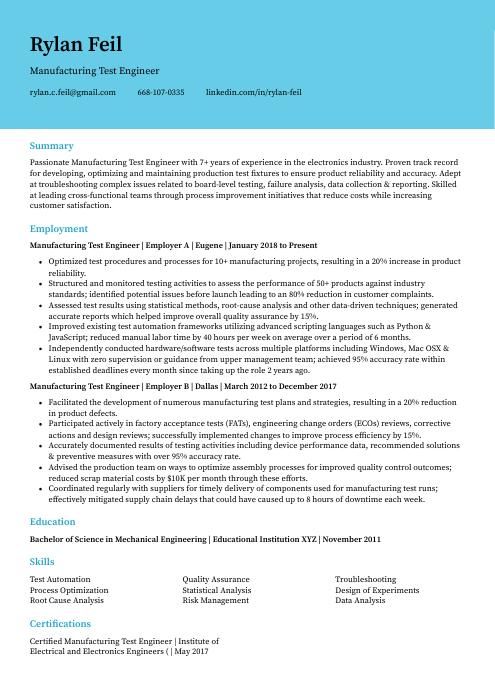 Dugong
Dugong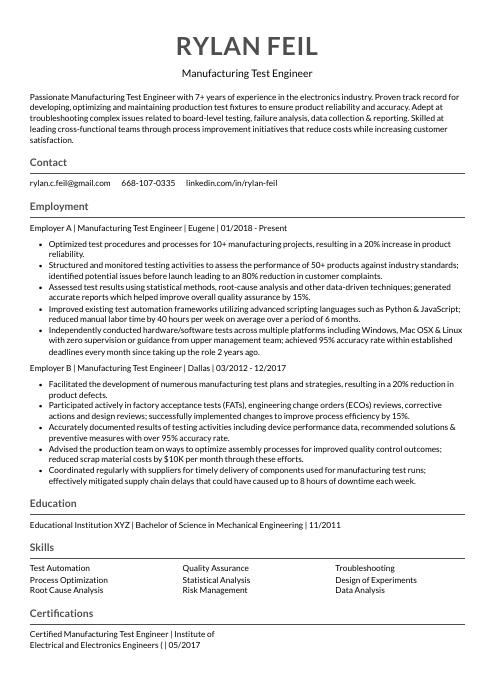 Indri
Indri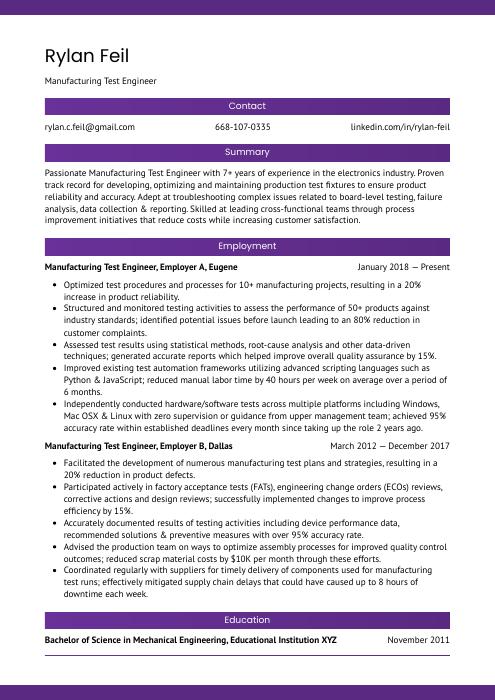 Jerboa
Jerboa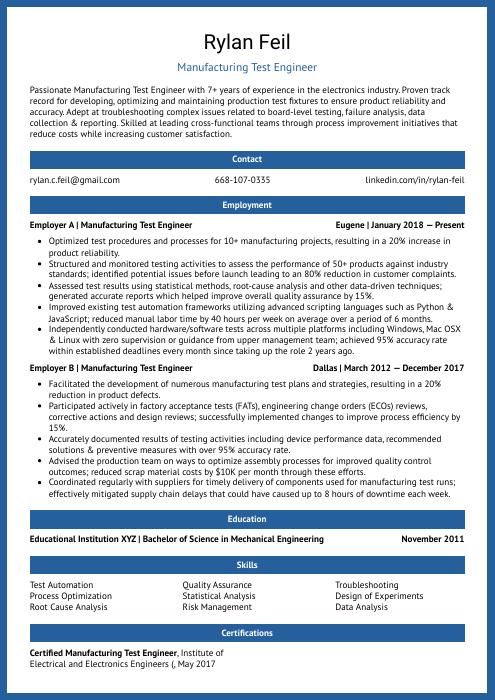 Ocelot
Ocelot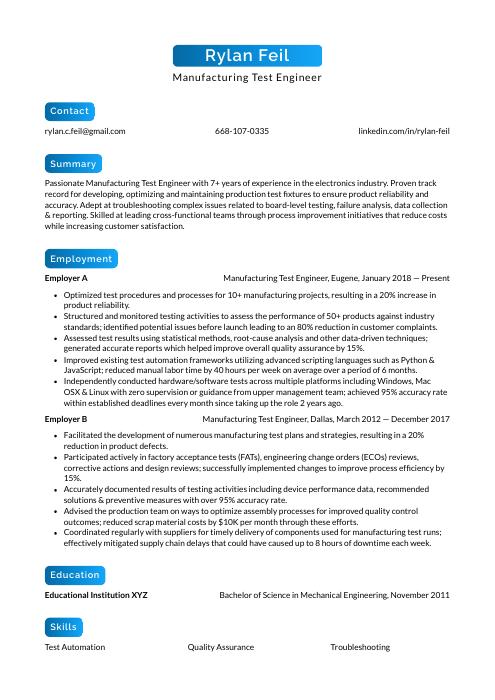 Kinkajou
Kinkajou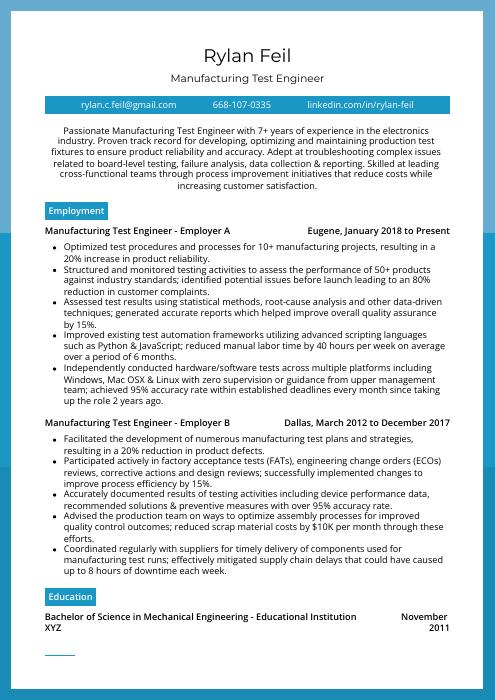 Rhea
Rhea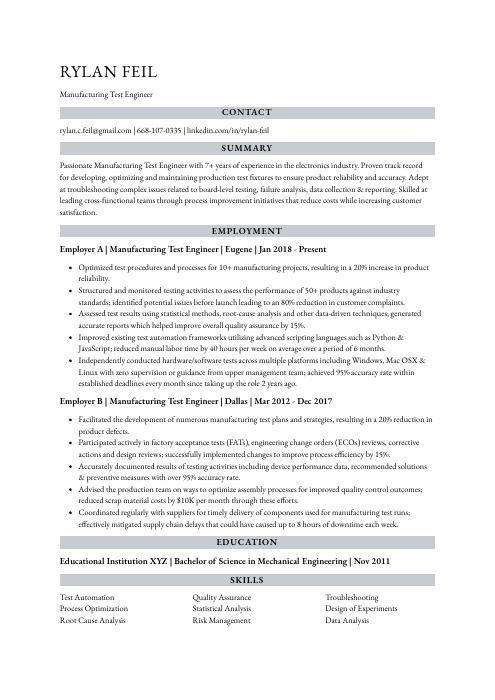 Numbat
Numbat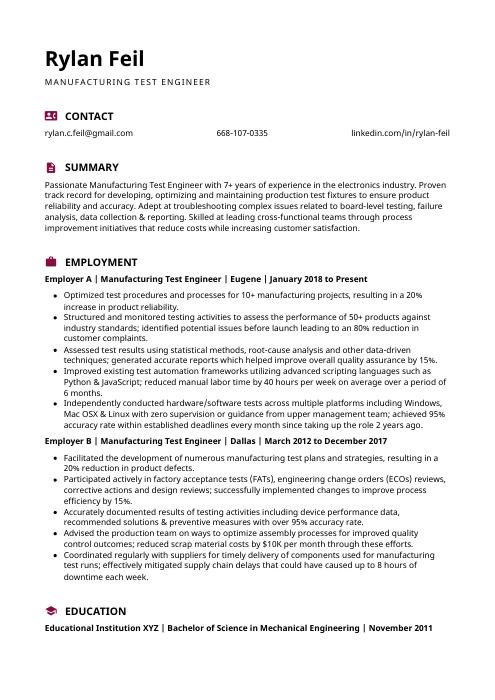 Hoopoe
Hoopoe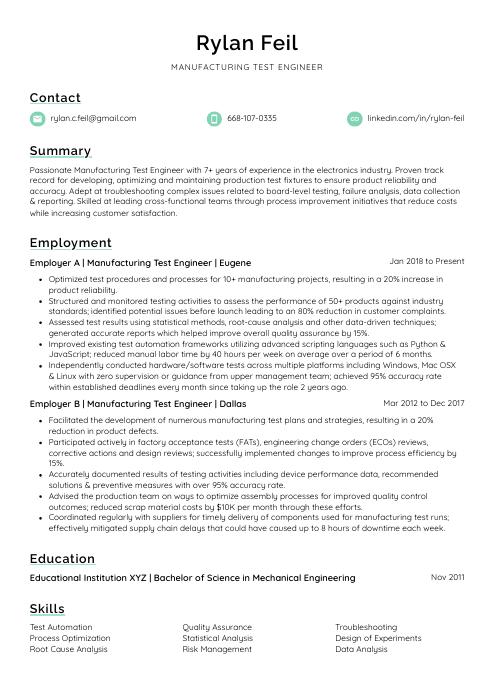 Lorikeet
Lorikeet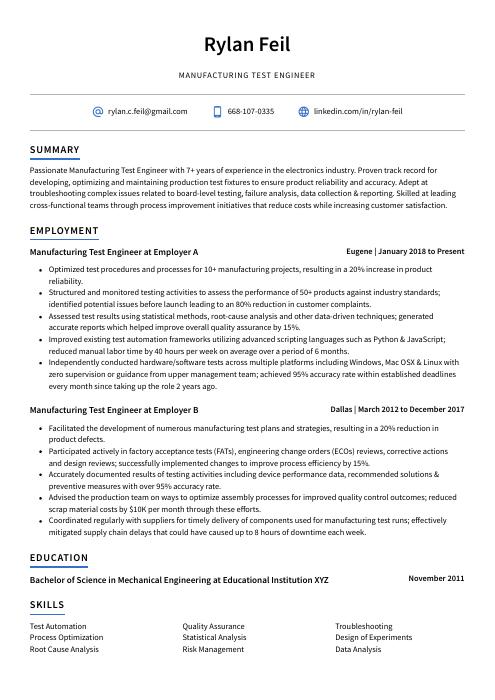 Axolotl
Axolotl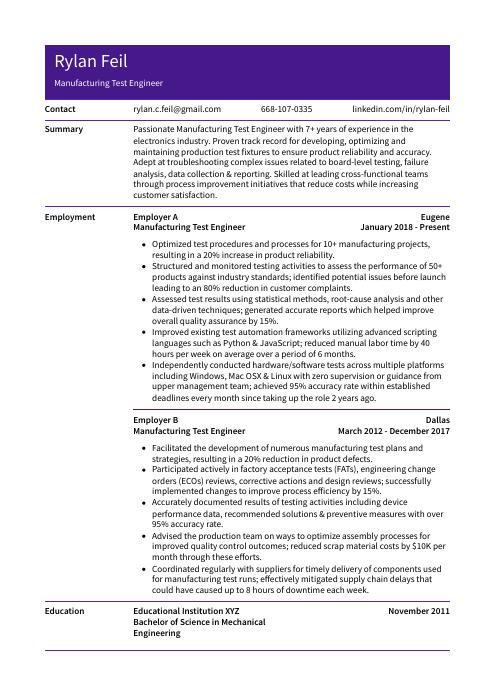 Pika
Pika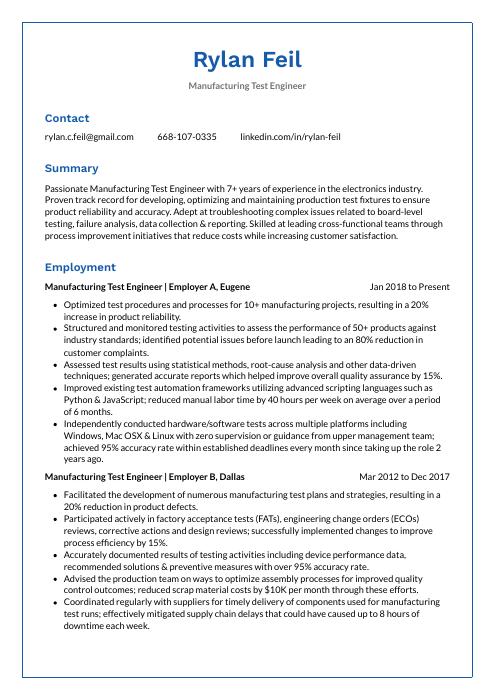 Markhor
Markhor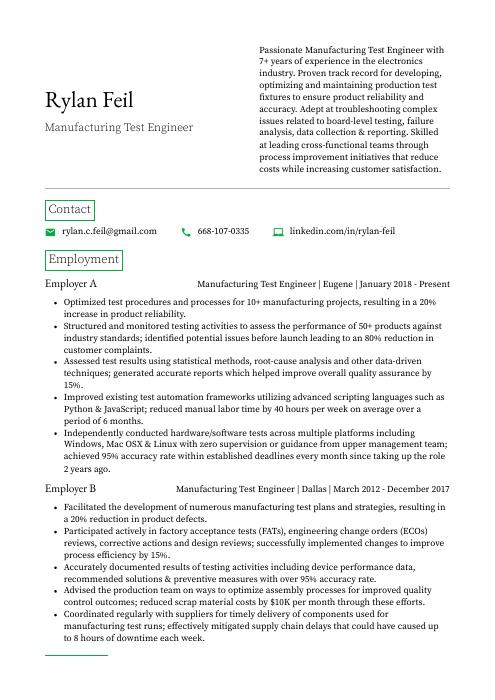 Quokka
Quokka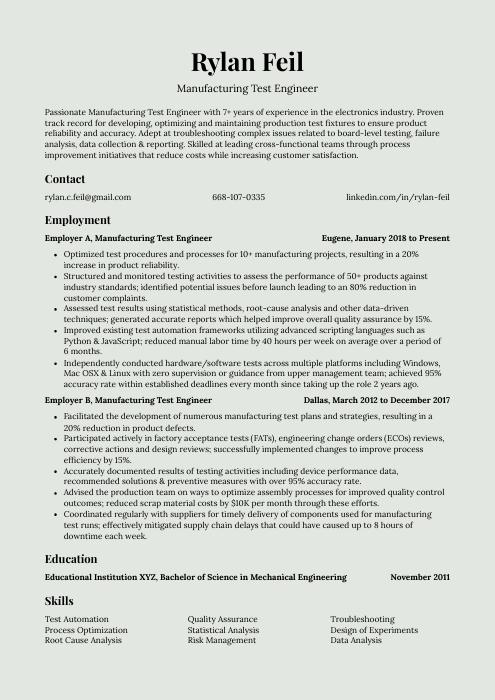 Saola
Saola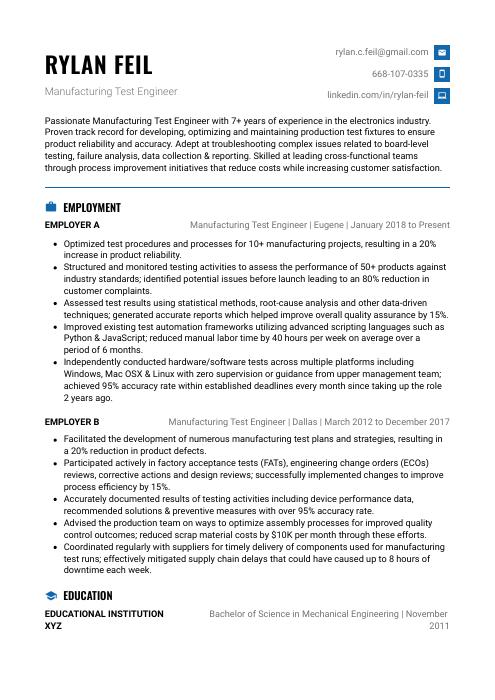 Echidna
Echidna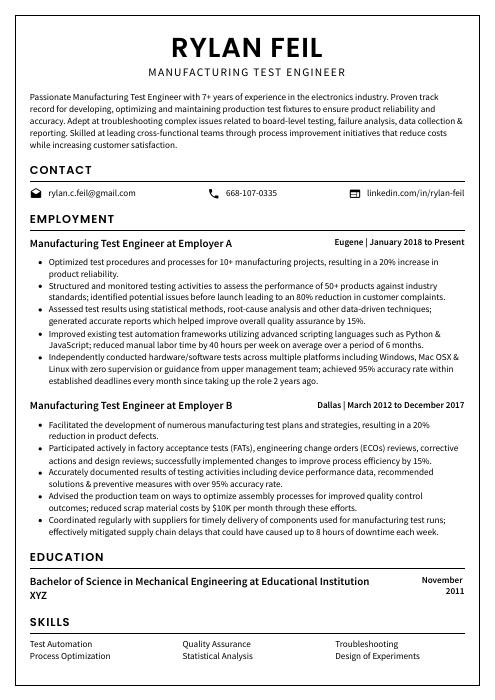 Cormorant
Cormorant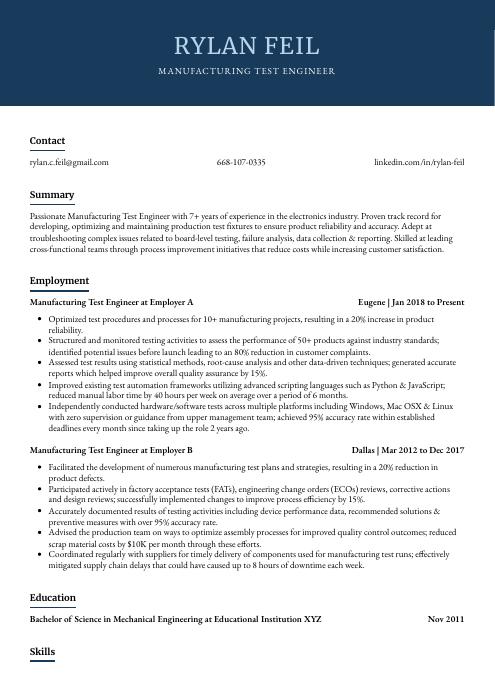 Bonobo
Bonobo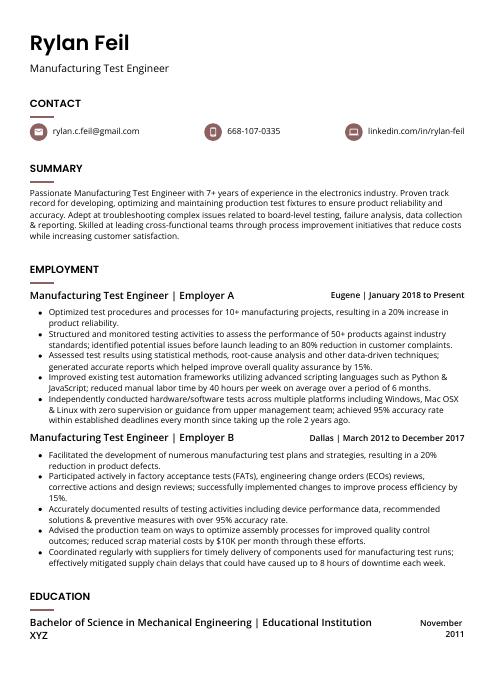 Fossa
Fossa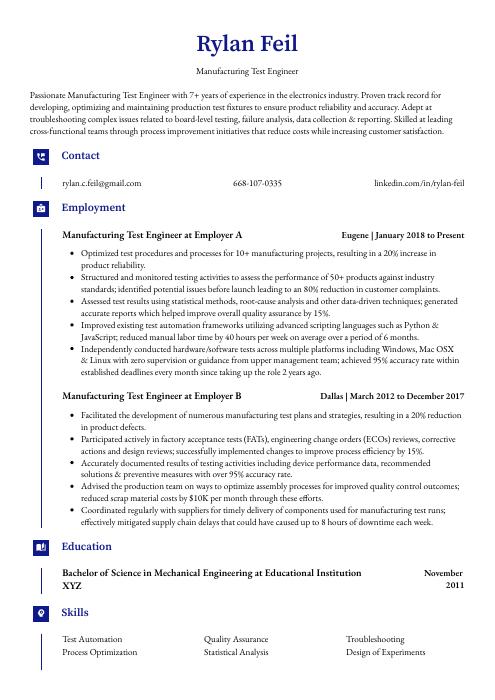 Gharial
Gharial Rezjumei
Rezjumei
